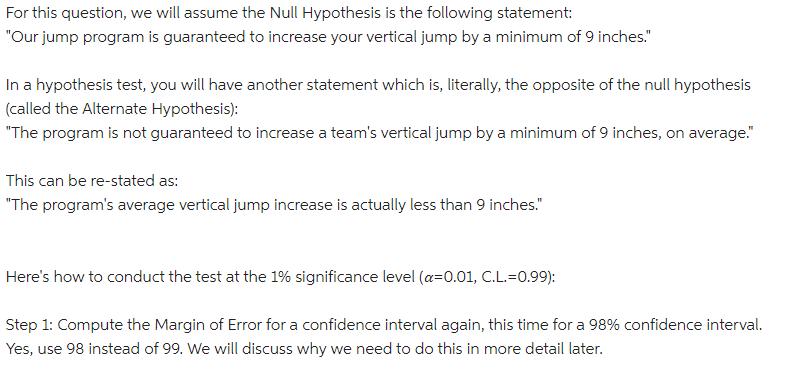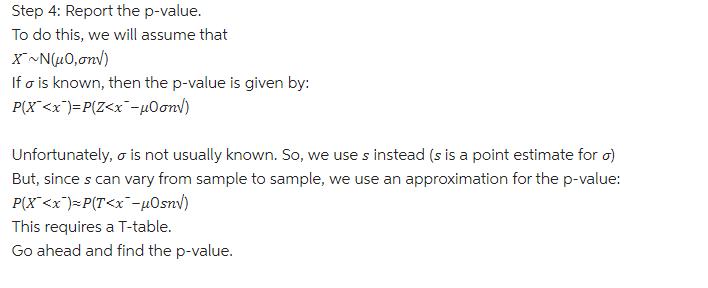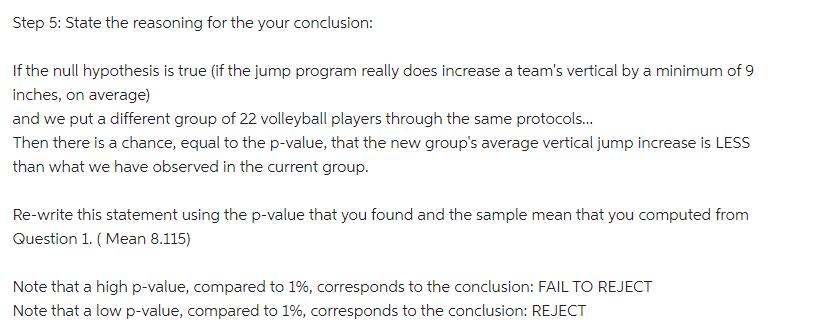Answered step by step
Verified Expert Solution
Question
1 Approved Answer
For this question, we will assume the Null Hypothesis is the following statement: Our jump program is guaranteed to increase your vertical jump by




For this question, we will assume the Null Hypothesis is the following statement: "Our jump program is guaranteed to increase your vertical jump by a minimum of 9 inches." In a hypothesis test, you will have another statement which is, literally, the opposite of the null hypothesis (called the Alternate Hypothesis): "The program is not guaranteed to increase a team's vertical jump by a minimum of 9 inches, on average." This can be re-stated as: "The program's average vertical jump increase is actually less than 9 inches." Here's how to conduct the test at the 1% significance level (a=0.01, C.L.=0.99): Step 1: Compute the Margin of Error for a confidence interval again, this time for a 98% confidence interval. Yes, use 98 instead of 99. We will discuss why we need to do this in more detail later. Step 2: Produce a 98% confidence interval. But there is a caveat: Unlike the confidence interval the you produced in Question 3 (a), you will center the interval at 0=9 instead of at the sample mean. Using the Margin of Error that you produced in Step 1, the interval should now look like: (H0-M.E.u0+M.E.) Step 3: Decide if the sample mean, x", is inside the interval produced in Step 2 or outside this interval. If the sample mean is inside the interval, you have no evidence to reject the null hypothesis: Conclusion: Fail to Reject the Null Hypothesis at the 1% significance level If the sample mean is outside the interval, you have evidence to reject the null hypothesis. Conclusion: Reject the Null Hypothesis at the 1% significance level. Step 4: Report the p-value. To do this, we will assume that X ~N(u0,onv) If o is known, then the p-value is given by: P(X Step 5: State the reasoning for the your conclusion: If the null hypothesis is true (if the jump program really does increase a team's vertical by a minimum of 9 inches, on average) and we put a different group of 22 volleyball players through the same protocols. Then there is a chance, equal to the p-value, that the new group's average vertical jump increase is LESS than what we have observed in the current group. Re-write this statement using the p-value that you found and the sample mean that you computed from Question 1. ( Mean 8.115) Note that a high p-value, compared to 1%, corresponds to the conclusion: FAIL TO REJECT Note that a low p-value, compared to 1%, corresponds to the conclusion: REJECT
Step by Step Solution
★★★★★
3.48 Rating (158 Votes )
There are 3 Steps involved in it
Step: 1

Get Instant Access to Expert-Tailored Solutions
See step-by-step solutions with expert insights and AI powered tools for academic success
Step: 2

Step: 3

Ace Your Homework with AI
Get the answers you need in no time with our AI-driven, step-by-step assistance
Get Started


